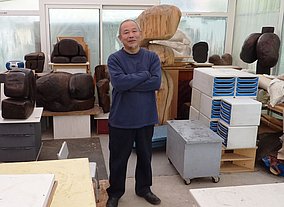Wang Keping
... was born on January 6, 1950, in Beijing, shortly after the communist army had entered the city still called "Peiping" at that time. The parent chose - in a patriotic gesture - the first name "Keping" which can be translated as "conquer (Pei)ping". Both parents had a communist background, Wang's father was a well-known writer, his mother an actress who had toured the communist frontlines during the anti-Japanese war.
In school, Wang was considered an insubordinate pupil because he liked to answer his teachers back. He was not admitted to the Young Pioneers in elementary school, and refused membership in the Communist Youth Leage when he was in middle school. In 1966, when the Cultural Revolution started, Wang joined one of the "rebel" factions that assaulted the local Communist Party seat in the city of Tianjin in 1966.
In 1969 though, the twenty-year-old Wang Keping was sent to a state farm in China's northernmost province of Heilongjiang for agricultural labor, but already in 1970, he managed to escape the harsh living conditions there through the help of his mother who used her connections to obtain a post in an army theater troop in Yunnan (Southwest China) for him. And in 1975 it was his father, who got him a job as a plumber in a factory near Beijing. There he learned to use a variety of tools, which should help him later in his artistic work as a sculptor. In 1976, Wang obtained a post at the drama department of China's Central TV station, which allowed him to return to Beijing.
When Mao had died in autumn of 1976, and the Gang of Four had been arrested, Wang Keping was also gripped by the general political fever of change. He sought contact with the dissidents and rights activists at Beijing's Democracy Wall, he gave some of his wooden sculptures political meanings, and he wrote a stageplay dealing with the Gang of Four that was published in one of the independent journals.
Wang Keping was also in the group of 23 young artists who dared to organize an open-air exhibition in late September 1979 that was swiftly closed down by police. When artists and political dissidents staged a street protest to demand freedoms a few days later on October 1 (China's National Day), Wang Keping was marching in the front row holding up a placard that said "We want artistic freedom".
In November 1979 and in August 1980, Wang took part in the now officially authorized exhibitions of the "Stars" group, showing his two most famous wooden sculptures "Idol" and "Silence", the first one a stretched head that resembles both Buddha and Mao, and the second one a bloated face with a blind eye and it's mouth gagged, which was widely understood as a symbol for missing freedoms of expression.
In 1984, Wang Keping got married to a French sinologist, and he moved with her to Paris. Only 26 years later he should travel to the People's Republic of China again, when he was invited to an arts exhibition in Shenzhen, just across the border from Hong Kong. In 2013 though, Wang was allowed to show more than 50 of his more recent sculptures in a special exhibition at the UCCA Gallery in the "798" cultural district of Beijing.
Interview with Wang Keping (on April 27, 2014 in his studio near Paris)
Here you find the Chinese text of the interview (an English translation will be provided later).







